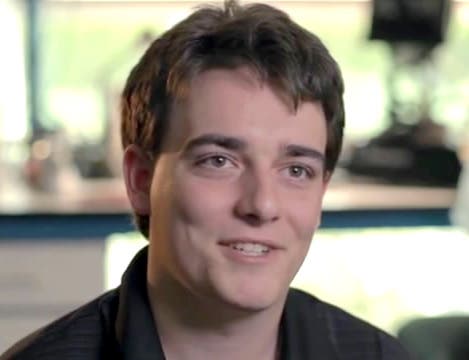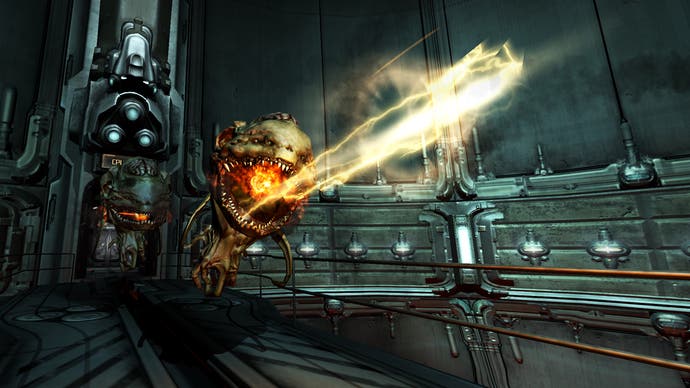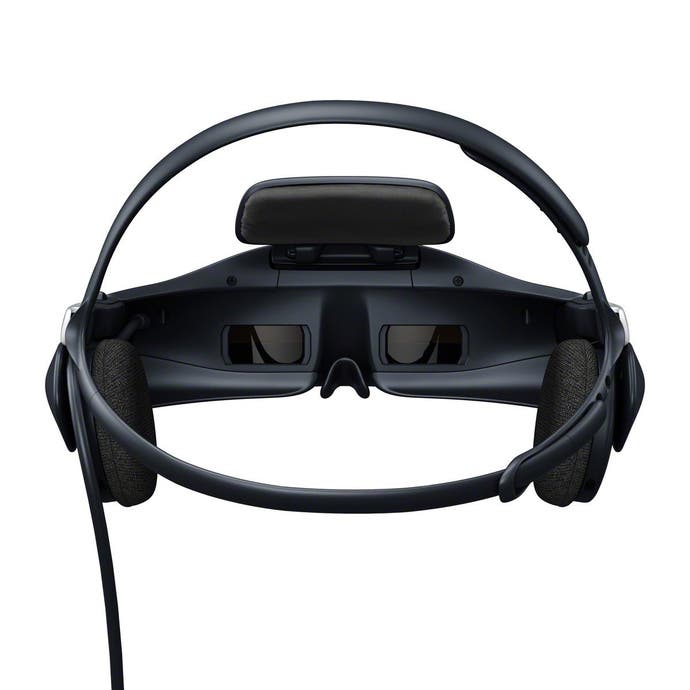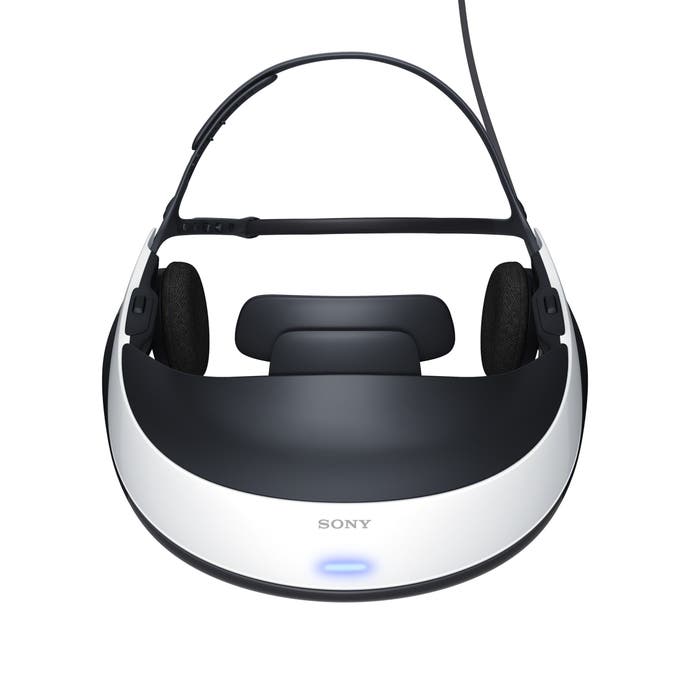Digital Foundry vs. Oculus Rift
Head-to-head with project creator Palmer Luckey - can this hardware Kickstarter revolutionise VR and stereo 3D?
"Really, all we've been doing in first-person shooters since I started is trying to make virtual reality. Really that's what we're doing with the tools we've got available. The whole difference between a game where you're directing people around and an FPS is, we're projecting you into the world to make that intensity, that sense of being there and having the world around you," John Carmack told Eurogamer at E3.
"And there's only so much you can do on a screen that you're looking at. In the very best game experiences, if you're totally in the zone and totally into the game that you're doing, you might sort of fade the rest of the world out and just focus on that. But if you're wandering around E3 and stopping to look at a game, it's so clear that you're looking at something on a screen and you're looking at it in a detached way. Even the best, most advanced FPSes. So the lure of virtual reality is always there, since the '90s."
Now, in 2012 - 20 years after the launch of id's genre-defining Wolfenstein 3D - it appears that PC hardware has finally caught up with the aspirations of John Carmack and the founding fathers of the first-person shooter genre. The Oculus Rift presents a comprehensive solution to the myriad challenges of virtual reality, marrying up a stereo 3D display possessing a phenomenal field-of-view with an ultra-low latency series of motion sensors that immerse you into gameplay in a way you have never experienced before.
This week, Oculus launched a Kickstarter, aimed at getting first-generation hardware into the hands of games developers the world over. Beginning with a relatively modest $250,000 goal, Oculus exceeded the target within hours and in less than two days, $1m of crowd-sourced funds had been generated. In this interview, Digital Foundry talks with Oculus head Palmer Luckey, covering the progress made with the device since the first prototype was revealed, along with a more in-depth chat on the capabilities of the unit and how the final retail product - due next year - will be improved over the first-gen offering.
I have always been into hardware, back from when I was little kid who took apart 100 per cent of the appliances around the house (putting them back together maybe 90 per cent of the time - sorry, Mom). One of my big hobbies has been portabilising, the art of turning home game consoles into self-contained handheld units by making a custom case with a display, controls, and batteries. I founded the ModRetro forums about three years ago, and it is currently the most active portabilising community out there. As I got more and more interested in VR, things escalated from brainstorming, to prototyping, to working for a US Army affiliate research center (the USC ICT Mixed Reality lab), to more prototyping, to the Rift! None of it would have been possible without the VR enthusiast community, particularly members of the MTBS3D forums.
The potential has been real to me since last summer, perhaps earlier. That is when I created the first prototypes of the design that has become the Rift, and I knew that this was it, this was how to solve the problem of high FOV. I am not a software developer myself, just a hardware guy, but two projects that I had early involvement with are Shayd, created by Juli Griffo and Wild Skies, a game being done by the Project Holodeck team - both of which are specifically targeted at VR hardware. Shayd was actually shown in the Kickstarter video - experiencing that for the first time last year was what convinced me that I had to make this something people could see for themselves.
"From the time I have spent playing Doom 3 in a Rift, I can safely say that it elevates the immersion far beyond anything you can get with a standard keyboard/monitor/mouse setup. It does not so much improve the game as improve the way you experience it."

From the time I have spent playing Doom 3 in a Rift, I can safely say that it elevates the immersion far beyond anything you can get with a standard keyboard/monitor/mouse setup. It does not so much improve the game as improve the way you experience it, but that experience is something you cannot get with any other hardware/software pairing.
It was not so much going quiet as being loud in different places. In the case of John Carmack, he was the one who came to me looking for a prototype, which was really the start of any inkling I had that other big developers might be interested. As all the pieces pulled together, my partners and I flew around to several developers with prototypes in our bags, showed them what it could do, and asked if they were interested. The response was almost universally positive! At one large company, there was literally a room full of developers all waiting their turn to try it, with many of them sending emails to their co-workers to get in the room ASAP. That is not to say that nobody had criticism (there was a lot of very honest and blunt critiquing), but nobody came away from a demonstration feeling negative about it.
With private funding comes private obligations. Crowd-funding makes it easy for the community to be part of the development, and it lets us work on making the best possible product without tying ourselves to any single developer. The goal here is to put truly immersive VR technology in the hands of every developer, not just a select few.
That would be fantastic! The more industry adopts it the better. It is too early to make a guess if it will happen across the board, but if virtual reality devices become a large enough force in the market, it only stands to reason that most companies in the industry will support them.
I have learned a lot of lessons working on the Rift design for the last two years on and off, and all of those lessons are going to be going into the dev kit version of the Rift. The two most important things in a headset are the field-of-view, and low-latency head tracking. Ultra-high resolution, tiny form factors, neither of those can make you feel like you are in the game unless you have high FOV and great head-tracking. There are other improvements that I would like to put into the dev kit, but I don't want to get into too much detail until I know for sure what can make it, and what cannot.
" It is too early to make a guess if it will happen across the board, but if virtual reality devices become a large enough force in the market, it only stands to reason that most companies in the industry will support them."

Not just yet. Carmack has said that he would like to support it in future id Software titles, and Notch has recently said that he would like to support it in his games (Minecraft would be amazing!) but at the risk of sounding like a tease, I can't personally confirm any further games. Those announcements will have to be done at the appropriate time by their respective companies.
The SDK, at a bare minimum, will handle control schemes, motion tracking, warping, and display configuration needed to get Rift support into games with as little effort on the part of the developer as possible. There is a wish list of other features (audio, motion controllers, variable per-hardware configuration), but we have to focus on the basics right now.
The price cut was made possible by two things. First, the decision was made to minimise profit in favour of getting Rifts into the hands of as many developers as possible. There is a margin to handle any unexpected costs, and we have figured out what it will take to make these, but the margins you often see on electronic devices (development kits in particular!) are just not there. The second factor involved taking a really hard look at the cost of components and fabrication, and focusing on minimising them as much as possible with the expectation of selling more than a thousand. Some of that is as simple as negotiating with suppliers, and some of it goes as far as developing things on our own that would have otherwise been done by third parties.
There is no significant technical barrier, even if we do not assume a standard HDMI interface. It is important to have standards for S3D, but the kind of deep integration needed for a good VR experience goes far beyond those standards. If the game was developed with a Rift in mind, and the console maker approved the Rift, then the biggest problems are solved! Consoles even make some pieces of the puzzle simpler than the PC, having a standardised set of hardware helps. To be honest, even current console hardware could run a compelling VR experience if the software were optimised enough. I have spoken to major platform holders, but there is nothing to announce at this time.
We are still looking into that. Microsoft, for example, can be picky about what kind of devices you hook up to their consoles, especially when those devices do things that none of their own hardware supports. There are some third-party controllers who have had problems with that, and while there are ways around it, the ideal situation would be to get approval. All of that is speculation, though, there is no console support planned in the immediate future, so it is a problem we can cross when we get to it.
"We really want to try and get this to brave developers so they can integrate support into their games. This is an amazing product that can provide an amazing gaming experience, but the consumer version is going to polish that and take it to the next level."
It could be used for movies, but that is not what it is aimed at. There are already some independent developers working on things like motion-tracked viewing of movies projected onto a virtual screen, but they are still in the early stages. If you want to watch movies on an HMD, my honest advice would be to buy a Sony HMZ-T1 or a SiliconMicroDisplay ST1080; they are aimed squarely at that market, and while they have serious shortcomings as VR devices, they deliver as personal movie screens very well.
The assembled development kits that people are receiving will be polished, professional-looking devices that look at home next to any other modern technology. There are also 100 unbuilt kits that are shipping earlier than the rest, and those use a shell that is very similar to the ones I have been using in the prototypes, though a bit cleaner.
We only sold 100 of the unbuilt kit, those are going to the VR enthusiasts and the hacker community that has been following the development of the Rift for some time now, not for the average developer. They are already sold out, but the general gist is that they will need screwing, gluing, and tweaking to function. The development kit Rifts are the main focus, and those are going to ship with a great-looking, comfortable, and lightweight plastic shell. The pre-built units will be professionally assembled, not by my team. I will be putting together a few to test fit and finish, but the majority will be done as part of the production process.
We really want to try and get this to brave developers so they can integrate support into their games. This is an amazing product that can provide an amazing gaming experience, but the consumer version is going to polish that and take it to the next level, hopefully with widespread game support. If someone is an average gamer, they should wait until next year.
"The current kit is the best we can put out right now at this moment without emptying wallets (think tens of thousands of dollars), but tech advancements can make big improvements possible in the near-future."

If the only major change is the screen, then yes, I can imagine that being possible, and I would certainly make that an option. As it stands, though, the LCD displays are the most expensive component in the Rift. If a new version of the Rift ended up being only slightly more expensive than the display on its own, then just buying the new version would probably make more sense. This is doubly true if there are changes made to the optics or tracking hardware.
An even wider field-of-view, and several times as many pixels as the development kit. The current kit is the best we can put out right now at this moment without emptying wallets (think tens of thousands of dollars), but tech advancements can make big improvements possible in the near-future.
It is too far away to predict a price, but the driving force behind creating Oculus was to create something that any gamer can afford. We are not losing money on or subsidising the development kit Rifts, and I think the price speaks for itself.
Almost certainly so. A large portion of our development team needs glasses (in fact, I am a little bit short-sighted myself), so compatibility with less than perfect vision is a high priority. There are a variety of ways to solve this, and we are going to figure out which is best.
Yes, it does! This is not only a function of hardware, though, it needs good software, something our SDK will make easy. With normal 3D displays, the field-of-view and focus of the display do not come even close to matching the view being rendered in software. By rendering an orthostereoscopic image, we can perfectly match the view of the Rift to the view you would see in the real world. If you are looking at a six-foot-tall enemy that is 10 feet away in the game, he will be exactly the same size he would be in real life. That is something you cannot easily solve with 3D monitors. Another advantage is that the optics collimate the light, giving you a view that is focused at infinity. This means you don't get the "I am looking at an up-close object" focus cues that come with 3D monitors.
It could, depending on how well it is implemented, and the features that it is tied to. I don't think that current eye-tracking tech or the tech that would benefit the most from it (variable focus/rendering detail) is at the point where it makes sense to do. Who knows what the future holds, though!
"The response shows that people really, really want an immersive VR experience, and to know that is so gratifying. Getting thousands of developer kits out there means that we are almost certainly going to see an explosion of VR content the likes of which has never been seen."


The technology is there, and it can be done with effectively zero latency (sub 1ms). The main problem is cost, at this point. For now, we want to focus on getting the core technology out to developers as fast as possible, and then look at improvements later.
Audio is definitely a big component, and we are looking into the possibility of integrating high-quality sound in the consumer version. Again, though, the goal is to get the core Rift tech out there as soon as possible.
There is so much to cover on the interface side of the equation, far too much to cover in a short answer! Best attempt at a short answer: A gamepad is going to be the default input device for the development kit, but we are looking into several other options. It is not an impossible challenge by any means, and the tech is out there in various forms, it just has to be pulled together into a package that is good for VR gaming.
The head-tracking does allow you to lean around corners to a limited degree by using translation of the tracker data. Having true positional data that lets you lean from side to side or lean in closer to things requires different sensors, something that is not going to be in the development kit.
S*** be crazy. To be serious, though, it has blown me away! The response shows that people really, really want an immersive VR experience, and to know that is so gratifying. Getting thousands of developer kits out there means that we are almost certainly going to see an explosion of VR content the likes of which has never been seen.

